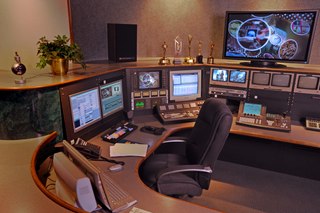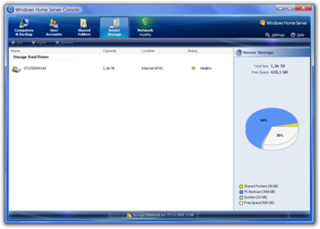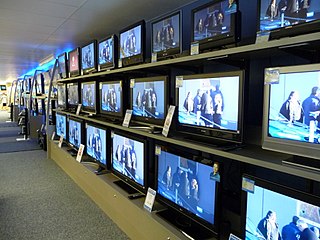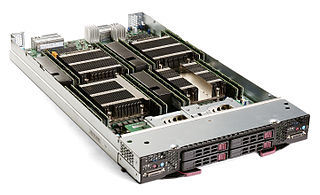Digital video is an electronic representation of moving visual images (video) in the form of encoded digital data. This is in contrast to analog video, which represents moving visual images with analog signals. Digital video comprises a series of digital images displayed in rapid succession.

Streaming media is multimedia that is constantly received by and presented to an end-user while being delivered by a provider. The verb "to stream" refers to the process of delivering or obtaining media in this manner; the term refers to the delivery method of the medium, rather than the medium itself, and is an alternative to file downloading, a process in which the end-user obtains the entire file for the content before watching or listening to it.

Non-destructive editing is a form of audio, video, and image editing in which the original content is not modified in the course of editing; instead the edits are specified and modified by specialized software. A pointer-based playlist, effectively an edit decision list (EDL), for video or a directed acyclic graph for still images is used to keep track of edits. Each time the edited audio, video, or image is rendered, played back, or accessed, it is reconstructed from the original source and the specified editing steps. Although this process is more computationally intensive than directly modifying the original content, changing the edits themselves can be almost instantaneous, and it prevents further generation loss as the audio, video, or image is edited.

A camcorder is an electronic device originally combining a video camera and a videocassette recorder.
A distributed data store is a computer network where information is stored on more than one node, often in a replicated fashion. It is usually specifically used to refer to either a distributed database where users store information on a number of nodes, or a computer network in which users store information on a number of peer network nodes.
CamCutter is a digital video camera technology developed by Ikegami and Avid Technology for recording broadcast quality video to hard disk, dubbed a Digital Disk Recorder. First revealed in 1995 at the National Association of Broadcasters convention in Las Vegas, it used a camera mechanism by Ikegami and a special FieldPack unit instead of a tape transport unit. The CamCutter outpaced subsequent tapeless camcorders introduced by Sony and Panasonic by years. In October 2010, the National Academy of Television Arts & Sciences (NATAS) announced the recipients of the 62nd Annual Technology & Engineering Emmy® Awards. Ikegami and Avid Technology were announced as a winner for the Development and Production of Portable Tapeless Acquisition. Today's CamCutter technology can be found in Ikegami's Editcam products.
Editcam is a professional digital camera system manufactured by Ikegami and first introduced in 1995, available both as professional camcorders and modular dock recorders. It is the first ever tapeless field acquisition device and has evolved into a range of SD and HD cameras. As a portable camera system, it can record digital video data direct to a hard disk drive (HDD).
Avid DNxHD is a lossy high-definition video post-production codec developed by Avid for multi-generation compositing with reduced storage and bandwidth requirements. It is an implementation of SMPTE VC-3 standard.
Avid Media Composer is a film and video editing software or non-linear editing system (NLE) and is the flagship product of Avid Technology. Initially released in 1989 on Macintosh II as an offline editing system, the application has since evolved to allow for both offline and online editing, including uncompressed standard definition (SD), high definition (HD), 2K and 4K editing and finishing. Since the 1990s, Media Composer has been the dominant non-linear editing system in the film and television industry, first on Macintosh and later on Windows. Avid NewsCutter, aimed at newsrooms, Avid Symphony, aimed at finishing, were all Avid products that were derived from Media Composer and share similar interfacing, as were Avid Xpress Pro and its predecessor Avid Xpress DV, which were aimed at the lower end of the market.

ABS-CBN is a Philippine free-to-air television network that is the flagship property of ABS-CBN Corporation, a company under the Lopez Group. The network is headquartered at the ABS-CBN Broadcasting Center in Quezon City, with additional offices and production facilities in 25 major cities including Baguio, Naga, Bacolod, Iloilo, Cebu, and Davao. ABS-CBN is formally referred to as "The Kapamilya Network"; kapamilya is a Filipino term which means a member of a family. This was originally introduced in 1999 and was officially introduced in 2003 during the celebration of its 50th anniversary. It is the largest television network in the country in terms of revenues, assets, and international coverage.

Compunet was a United Kingdom based interactive service provider, catering primarily for the Commodore 64 but later for the Commodore Amiga and Atari ST. It was also known by its users as CNet.
Magnetic tape data storage is a system for storing digital information on magnetic tape using digital recording. Modern magnetic tape is most commonly packaged in cartridges and cassettes. The device that performs writing or reading of data is a tape drive. Autoloaders and tape libraries automate cartridge handling. For example, a common cassette-based format is Linear Tape-Open, which comes in a variety of densities and is manufactured by several companies.

Windows Home Server is a home server operating system from Microsoft. It was announced on 7 January 2007 at the Consumer Electronics Show by Bill Gates, released to manufacturing on 16 July 2007 and officially released on 4 November 2007.

Avid DS is a high-end offline and finishing system comprising a non-linear editing system and visual effects software. It was developed by Softimage in Montreal. Softimage was owned by Microsoft at the time of the launch of DS v1.0 and the company was acquired by Avid Technology Inc shortly thereafter.
Uncompressed video is digital video that either has never been compressed or was generated by decompressing previously compressed digital video. It is commonly used by video cameras, video monitors, video recording devices, and in video processors that perform functions such as image resizing, image rotation, deinterlacing, and text and graphics overlay. It is conveyed over various types of baseband digital video interfaces, such as HDMI, DVI, DisplayPort and SDI. Standards also exist for carriage of uncompressed video over computer networks.
The National Center for Computational Sciences (NCCS) is a United States Department of Energy Leadership Computing Facility. The NCCS provides resources for calculation and simulation in fields including astrophysics, materials, and climate research. This research is intended to enhance American competitiveness in industry. The NCCS, founded in 1992 and located at Oak Ridge National Laboratory (ORNL), currently manages a 2.33-petaflop Cray XT5 supercomputer named Jaguar for use in open research by academic and corporate researchers. Jaguar was named the world's fastest computer at SC09, a position it held until October 2010. Founded in 1992, the NCCS is a managed activity of the Advanced Scientific Computing Research program of the Department of Energy Office of Science (DOE-SC).
The National Institute for Computational Sciences (NICS) is funded by the National Science Foundation and managed by the University of Tennessee. NICS was home to Kraken, the most powerful computer in the world managed by academia. The NICS petascale scientific computing environment is housed at Oak Ridge National Laboratory (ORNL), home to the world's most powerful computing complex. The mission of NICS, a member of the Extreme Science and Engineering Discovery Environment, is to enable the scientific discoveries of researchers nationwide by providing leading-edge computational resources, together with support for their effective use, and leveraging extensive partnership opportunities.
FlipFactory from Telestream is a video transcoding and workflow automation application. It enables the transfer of media and metadata files between professional video systems, including catch servers, broadcast servers, edit systems, streaming and distribution servers, storage area networks and digital asset management systems.
Ingex is an open-source (GPL) suite of software for the digital capture of audio and video data, without the need for traditional audio or video tape or cassettes. Serial digital interface (SDI) capture is supported, as well as real-time transcoding. Portions of the software suite also act as a network file server for media files, as well as archiving to LTO-3 data tape. Audio and video media files can also be stored on USB hard drives or Network Attached Storage. The software is heavily used by the BBC, and was developed by the BBC Research Laboratory.











